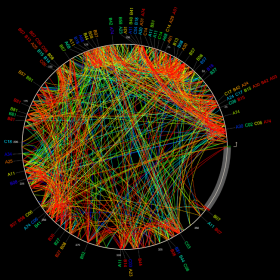Phylogenetic Dependency Networks: Inferring Patterns of CTL Escape and Codon Covariation in HIV-1 Gag
- Jonathan M. Carlson ,
- Zabrina L. Brumme ,
- Christine M. Rousseau ,
- Chanson J. Brumme ,
- Philippa Matthews ,
- Carl Kadie ,
- James I. Mullins ,
- Bruce D. Walker ,
- P. Richard Harrigan ,
- Philip J. R. Goulder ,
- David Heckerman
PLoS Computational Biology | , Vol 4: pp. e1000225

Phylogenetic dependency networks
 This paper (opens in new tab) is the introduction of the Phylogenetic Dependency Network framework. The idea is that we build independent models of evolution for each amino acid in an HIV protein. One of those models is parameterized by the phylogenetic structure, the rate of evolution in the absence of escape, and a model of adaptation in the leaves of the phylogeny. Crucially, we assume that adaptation exists only in the leaves (ie, the observed patients). This is clearly wrong, but quite useful in that it keeps the number of parameters linear, and empirically it’s a decent approximation, as we showed previously (opens in new tab). This paper is the foundation of all of our HIV escape work and has been cited (opens in new tab) numerous times. The image on the left was used as the cover image (opens in new tab) for this article, as well as the PLoS T-shirt logo for the 2009 ISMB conference.
This paper (opens in new tab) is the introduction of the Phylogenetic Dependency Network framework. The idea is that we build independent models of evolution for each amino acid in an HIV protein. One of those models is parameterized by the phylogenetic structure, the rate of evolution in the absence of escape, and a model of adaptation in the leaves of the phylogeny. Crucially, we assume that adaptation exists only in the leaves (ie, the observed patients). This is clearly wrong, but quite useful in that it keeps the number of parameters linear, and empirically it’s a decent approximation, as we showed previously (opens in new tab). This paper is the foundation of all of our HIV escape work and has been cited (opens in new tab) numerous times. The image on the left was used as the cover image (opens in new tab) for this article, as well as the PLoS T-shirt logo for the 2009 ISMB conference.
Abstract
One of the enduring challenges facing HIV vaccine design is the remarkable rate of viral mutation and adaptation that limits the ability of the immune system to mount a lasting effective response. This rapid rate of mutation leads to extensive within- and between-host viral diversity that makes creation of a broadly reactive vaccine difficult. A first step in overcoming this challenge is to identify consistent patterns in viral adaptation. Recently, several studies have analyzed large groups of HIV-infected individuals and looked for correlations between HIV polymorphisms and the HLA class I alleles that restrict the cellular immune response. Here, we point out a limitation of previous approaches: correlations among HLA alleles and HIV codons lead to statistical confounding if not taken into consideration. In response, we develop two statistical models of evolution that explicitly represent stochastic selection pressure from multiple sources. After validating these models on synthetic data, we analyze the patterns of immune escape in a multicenter cohort of over 1000 individuals. Our results identify a dense network of interactions between HLA alleles and HIV codons, as well as among HIV codons, reflecting both a complexity and a promising consistency in the way that HIV adapts to the human immune response.
Open AccessEverything we publish is freely available online throughout the world, for you to read, download, copy, distribute, and use (with attribution) any way you wish. No permission required. Read a detailed definition of Open Access.
